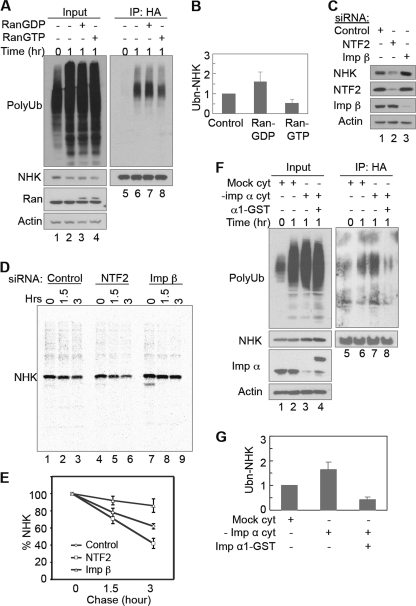FIGURE 7.
RanGDP but not RanGTP promotes ERAD of NHK. A, RanGDP promotes, whereas RanGTP inhibits, NHK ubiquitination in vitro. 1 μg of Ran preloaded with GDP or GTP was used in in vitro NHK ubiquitination as indicated. His-tagged recombinant Ran is ∼1 kDa larger than endogenous Ran. B, quantification of NHK ubiquitination in A. The data represent the means ± S.E. of three independent experiments. The relative intensity of polyubiquitin smear (Ubn-NHK) in reaction with control cytosol for 1 h (lane 6) was set to 1. C and D, HEK293 cells stably expressing NHK were transfected with siRNA targeting NTF2 or importin β as indicated. 48 h after transfection, the cells were processed for IB (C), or cells were pulse-labeled and chased for the indicated times before being processed for IP with anti-A1AT antibodies (D). E, quantification of NHK degradation in D. The data represent the means ± S.E. of three independent experiments. The relative band intensity of NHK at chase 0 h was set to 100%. F, importin α inhibits NHK ubiquitination in vitro. Importin α in the cytosol was depleted (−imp α cyt) by incubating the cytosol with Ni-NTA-agarose prebound with His-tagged importin β-ΔN169 at 4 °C for 2 h. Mock control was incubated with Ni-NTA-agarose only. 1 μg of importin α1-GST was used as indicated. G, quantification of NHK ubiquitination in F. The data represent the means ± S.E. of three independent experiments. The relative intensity of the polyubiquitin smear (Ubn-NHK) in the reaction with mock cytosol for 1 h (lane 6) was set to 1. Imp, importin.

